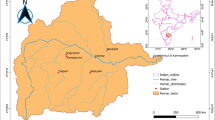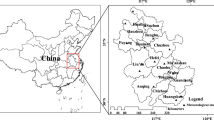Abstract
Drought is a complex, multi-dimensional, and recurrent natural hazard that impacts on the Earth hydrological and biological systems. The cause–effect relationship of meteorological and hydrological droughts induced the study to aim at evaluating capability of a copula-based joint meteorological–hydrological drought index (MHDI) in identifying overall status of droughts at upstream and downstream of the Kasilian basin. Using three meteorological drought indices (MDIs) including standardized precipitation index (SPI), standardized precipitation evapotranspiration index (SPEI), and reconnaissance drought index (RDI) and one hydrological drought index (i.e., standardized drought index (SDI)), three different combinations of MHDI including SPI–SDI, SPEI–SDI, and RDI–SDI were constructed at the upstream and downstream of the basin. Results of the dependence measures such as Kendall’s τ and chi-plot showed that there were relatively high correlation structure between MDIs and SDI at both upstream and downstream. Evaluation of fitting six popular copula functions on dependence structure of different combinations of meteorological and hydrological drought revealed that the normal, Frank, Gumbel, and Joe copulas were the best-fit functions in most cases, respectively. MHDIs appropriately detected the onset and persisting of historical drought periods at both upstream and downstream of the basin. They satisfactorily responded to joint meteorological and hydrological drought indices. Establishing the normal meteorological (hydrological) condition in the basin could modify the extreme hydrological (meteorological) droughts when employing them in the framework of MHDI.







Similar content being viewed by others
Abbreviations
- JDI:
-
Joint deficit index
- MK:
-
Mann–Kendall test
- MSDI:
-
Multivariate standardized drought index
- P:
-
Precipitation
- PE:
-
Potential evapotranspiration
- RDI:
-
Reconnaissance drought index
- SDI:
-
Streamflow drought index
- SPEI:
-
Standardized precipitation evapotranspiration index
- SPI:
-
Standardized precipitation index
References
Abdi A, Hassanzadeh Y, Ouarda TBMJ (2017) Regional frequency analysis using growing neural gas network. J Hydrol 550:92–102
Akaike H (1974) A new look at the statistical model identification. IEEE Trans Autom Control 19(6):716–723
Balint Z, Mutua F, Muchiri P, Omuto CT (2013) Chapter 23—monitoring drought with the combined drought index in Kenya. In: Paolo Paron DOO, Christian Thine O (eds) Developments in earth surface processes, vol 16. Elsevier, pp 341–356. https://doi.org/10.1016/B978-0-444-59559-1.00023-2
Bazrafshan J (2017) Effect of air temperature on historical trend of long-term droughts in different climates of Iran. Water Resour Manag 31:4683–4698. https://doi.org/10.1007/s11269-017-1773-8
Bazrafshan J, Heidari N, Moradi I, Aghashariatmadary Z (2015a) Simultaneous stochastic simulation of monthly mean daily global solar radiation and sunshine duration hours using copulas. J Hydrol Eng 20(4):04014061
Bazrafshan J, Hejabi S, Rahimi J (2014) Drought monitoring using the multivariate standardized precipitation index (MSPI). Water Resour Manag 28(4):1045–1060
Bazrafshan J, Nadi M, Ghorbani K (2015b) Comparison of empirical copula-based joint deficit index (JDI) and multivariate standardized precipitation index (MSPI) for drought monitoring in Iran. Water Resour Manag 29(6):2027–2044
Burnham KP, Anderson DR (2002) Model selection and multimodel inference: a practical information—theoretical approach. Springer, New York
Chang J, Li Y, Wang Y, Yuan M (2016) Copula-based drought risk assessment combined with an integrated index in the Wei River Basin, China. J Hydrol 540:824–834
Crausbay SD, Ramirez AR, Carter SL, Cross MS, Hall KR, Bathke DJ, Betancourt JL, Colt S, Cravens AE, Dalton MS, Dunham JB, Hay LE, Hayes MJ, McEvoy J, McNutt CA, Moritz MA, Nislow KH, Raheem N, Sanford T (2017) Defining ecological drought for the twenty-first century. Bull Am Meteorol Soc 98:2543–2550
Fisher NI, Switzer P (1985) Chi-plots for assessing dependence. Biometrika 72(2):253–265
Fisher NI, Switzer P (2001) Graphical assessment of dependence: is a picture worth 100 tests? Am Stat 55(3):233–239
Hao Z, AghaKouchak A (2013) Multivariate standardized drought index: a parametric multi-index model. Adv Water Resour 57:12–18
Hubert M, Vandervieren E (2008) An adjusted boxplot for skewed distributions. Comput Stat Data Anal 52(12):5186–5201
Hurst HE (1951) Long-term storage capacity of reservoirs. Trans Am Soc Civ Eng 116(1):770–799
Kao S-C, Govindaraju RS (2010) A copula-based joint deficit index for droughts. J Hydrol 380(1–2):121–134
Kendall MG (1970) Rank correlation methods. Griffin, London
Keyantash JA, Dracup JA (2004) An aggregate drought index: assessing drought severity based on fluctuations in the hydrologic cycle and surface water storage. Water Resour Res 40(9):W09304
Ma M, Ren L, Singh VP, Tu X, Jiang S, Liu Y (2015) Evaluation and application of the SPDI–JDI for droughts in Texas, USA. J Hydrol 521:34–45
Mann HB (1945) Nonparametric tests against trend. Econometrica 13(3):245–259
McKee TB, Doesken NJ, Kleist J (1993) The relationship of drought frequency and duration to time scales. Proc Eighth Conference Appl Climatol, American Meteorological Society, Boston pp. 179–184
Mirabbasi R, Anagnostou EN, Fakheri-Fard A, Dinpashoh Y, Eslamian S (2013) Analysis of meteorological drought in northwest Iran using the joint deficit index. J Hydrol 492:35–48
Mishra AK, Singh VP (2010) A review of drought concepts. J Hydrol 391(1):202–216
Mishra AK, Singh VP (2011) Drought modeling—a review. J Hydrol 403(1):157–175
Murthy CS, Singh J, Kumar P, Sesha Sai MVR (2017) A composite index for drought hazard assessment using CPC rainfall time series data. Int J Environ Sci Technol 14(9):1981–1988
Nalbantis I, Tsakiris G (2009) Assessment of hydrological drought revisited. Water Resour Manag 23(5):881–897
Nelsen RB (2006) An introduction to copulas (Springer Series in Statistics). Springer–Verlag New York, Inc, New York
Pettitt AN (1979) A non-parametric approach to the change-point problem. J R Stat Soc Ser C Appl Stat 28(2):126–135
Rad AM, Ghahraman B, Khalili D, Ghahremani Z, Ardakani SA (2017) Integrated meteorological and hydrological drought model: a management tool for proactive water resources planning of semi-arid regions. Adv Water Resour 107:336–353
Tabari H, Nikbakht J, Hosseinzadeh Talaee P (2013) Hydrological drought assessment in northwestern Iran based on streamflow drought index (SDI). Water Resour Manag 27(1):137–151
Tallaksen LM, Van Lanen HAJ (2004) Hydrological drought: processes and estimation methods for streamflow and groundwater. Developments in Water Science, vol 48. Elsevier Science BV, Amsterdam, the Netherlands
Tsakiris G, Pangalou D, Vangelis H (2007) Regional drought assessment based on the reconnaissance drought index (RDI). Water Resour Manag 21(5):821–833
Tsakiris G, Vangelis H (2005) Establishing a drought index incorporating evapotranspiration. Eur Water 9–10:3–11
Van Lanen HAJ (2006) Drought propagation through the hydrological cycle. In: Demuth S, Gustard A, Planos E, Scatena F, Servat E (eds) Climate variability and change. IAHS Press, Wallingford, pp 122–127
Van Loon AF (2015) Hydrological drought explained. Wiley Interdiscip Rev Water 2(4):359–392
Van Loon F (2013) On the propagation of drought. How climate and catchment characteristics inflence hydrological drought development and recovery. PhD Thesis Thesis, Wageningen University, Wageningen, the Netherlands
Vicente-Serrano SM, Beguería S, López-Moreno JI (2010) A multiscalar drought index sensitive to global warming: the standardized precipitation evapotranspiration index. J Clim 23(7):1696–1718
Vicente-Serrano SM et al (2012) Accurate computation of a streamflow drought index. J Hydrol Eng 17(2):318–332
Waseem M, Ajmal M, Kim T-W (2015) Development of a new composite drought index for multivariate drought assessment. J Hydrol 527:30–37
Wilhite DA, Glantz MH (1985) Understanding: the drought phenomenon: the role of definitions. Water Int 10(3):111–120
Wilhite DA, Sivakumar MVK, Pulwarty R (2014) Managing drought risk in a changing climate: the role of national drought policy. Weather Clim Extrem 3:4–13
Young KC (1992) A three-way model for interpolating for monthly precipitation values. Mon Weather Rev 120(11):2561–2569
Zare M, Nazari Samani AA, Mohammady M, Salmani H, Bazrafshan J (2017) Investigating effects of land use change scenarios on soil erosion using CLUE-s and RUSLE models. Int J Environ Sci Technol 14(9):1905–1918
Zhang D, Chen P, Zhang Q, Li X (2017) Copula-based probability of concurrent hydrological drought in the Poyang lake-catchment-river system (China) from 1960 to 2013. J Hydrol 553:773–784
Author information
Authors and Affiliations
Corresponding author
Ethics declarations
Conflict of interest
The authors declare that they have no conflict of interest.
Rights and permissions
About this article
Cite this article
Cheraghalizadeh, M., Ghameshlou, A.N., Bazrafshan, J. et al. A copula-based joint meteorological–hydrological drought index in a humid region (Kasilian basin, North Iran). Arab J Geosci 11, 300 (2018). https://doi.org/10.1007/s12517-018-3671-7
Received:
Accepted:
Published:
DOI: https://doi.org/10.1007/s12517-018-3671-7




